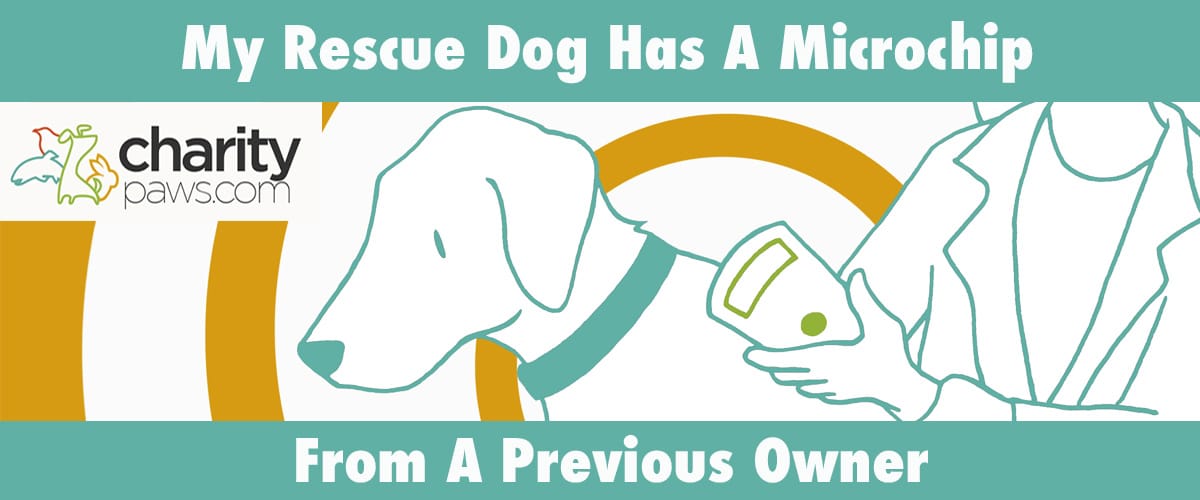Many dogs are microchipped as it is an excellent way of identifying an animal and reuniting them with their owner if they get lost.
But what happens if a your new rescue dog has a microchip from a previous owner and you want to take on that dog? Let’s explore the process of how the information gets changed, as well as find out a bit more about microchips themselves.

What Are Microchips And How Are They Used?
A microchip is a small implant, approximately 12mm long (about the size of a large grain of rice). It is inserted via a needle into the scruff of a dog’s neck, by someone who is trained in microchip implantation, such as a veterinarian.
This procedure should be no more painful than an injection, and is over in a matter of seconds, leaving the microchip sitting permanently in the layer of fat under the animal’s skin.
This microchip contains a number, which is a bit like a unique barcode for that animal. Information is held on a database against that number, such as:
- Owner details and information about the pet
- Animal’s date of birth
- Breed
- Important medical information
Owners can also put an alert on the system stating that their animal is lost so that this comes up as a clear flag.
If an animal is brought into a veterinary hospital or picked up by animal control they will scan them using a microchip scanner to obtain that number. They can then use this number to work out which company the microchip is registered to and call them to get all of this information from their database.
This means that the animal’s owners can be contacted and hopefully the pet can be safely reunited with them.
It is worth remembering that microchips are not GPS trackers. This means that they can’t tell us the whereabouts of the animal if they go missing, instead it relies on someone finding the animal and scanning them.
The technology is not yet available to have GPS microchips.
However, microchips are the best way of reuniting owners with their pets. A collar and ID tag can easily be removed or broken, leaving the dog without any form of identification.
If you are looking to have GPS monitoring of your dog, then the only options are items that are worn, such as a collar with a GPS enabled beacon.
In some countries microchipping is mandatory. While this is not yet the case in the US, it is still highly recommended by vets and animal charities as part of responsible pet ownership.
Sadly, unidentifiable dogs can end up in shelters, some of which have a euthanasia policy if the animal has been unclaimed for an extended period. A microchip should prevent this from happening.
It’s worth noting that both dogs and cats can have microchip implants.
What You Need To Do To Transfer Microchip Registration Details
There are clear benefits to having your dog microchipped, but what happens if the details need to be altered?
This often happens during a change of ownership when the new owners wish for their details to be held on the microchip.
The easiest way for this to happen is for the old owners to transfer the registration for you. They will be able to contact their microchip company or log in online to perform a change of ownership directly.
After they fill out the details at their end you will receive an email, text, or phone call to accept the change in ownership. You should receive confirmation that this has taken place.
Alternatively, if you have been given the dog’s microchip number and know which company/database they are registered to, then you can contact the relevant company yourself and ask for a change of ownership to take place. The microchip company will then contact the previous owners on your behalf to seek their permission for this to happen.
How To Change Microchip Details Without The Previous Owner
There are some situations where it is not possible to contact the owner to request permission to change microchip details.
For example, if the animal has been picked up as a stray and the owner’s details are incorrect/out of date on the chip.
In this scenario, you will need to do the following:
- Ask the shelter or a vet to scan the pet’s microchip for you to obtain the number
- Input the number into a website such as American Animal Hospital Association (AAHA) to find out what company the microchip is registered with
- Contact that microchip company via their website or call center to ask them about their process. The microchip company will try and contact the owner to ask for their permission to change ownership. If they are unable to do so because the owner is not responding or their contact details are invalid, they will then inform you of the next steps. This may involve waiting a certain period to see if the previous owner replies to their messages, before transferring the chip details over to you.
What Is The Correct Way To Rehome A Dog With A Microchip
If you are rehoming a dog from a shelter then they will be able to help you navigate the adoption process and the paperwork. But if you are doing it privately then you will need to gather all the information from the dog’s owners.
- First and foremost, visit the dog before making any decisions about whether to rehome them. Try to see them in their home environment and make sure you go with a level head so that you are prepared to walk away if things are not quite right. Never meet someone in a random parking lot.
- Ask the owner for a copy of the dog’s medical history. This will allow you to see if the dog has had any previous health complaints or behavioral issues that you should be aware of.
- Ask for a copy of the dog’s vaccination card. The dog’s vaccination history should be on their vet’s notes, but it is still good to have the physical vaccination card if you can.
- Ask for the dog’s microchip details. If the owner knows the dog’s microchip number and the company the chip is registered to then this will help make the transferring process easier. It is usually easiest if the original owner starts the transfer of ownership process, but either way can work.

The Importance Of Updating Your Dog’s Microchip Information
When rehoming a dog it is important to make sure that you transfer ownership properly and register your personal details to the microchip.
It is also important to make sure that your information is kept up to date, which means contacting the microchip company any time that you change your address or telephone number. This will help to ensure that your new dog is reunited with you if he ever goes missing.
While it can be easy to get caught up in the excitement of getting a new dog, make sure you take the time to do things properly. After all, a microchip could help save their life one day.

